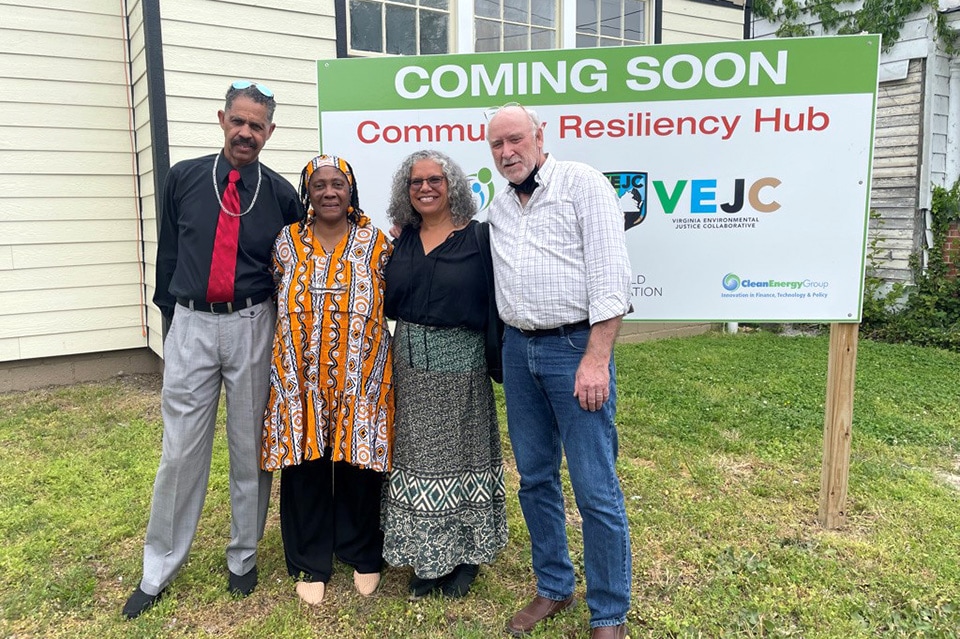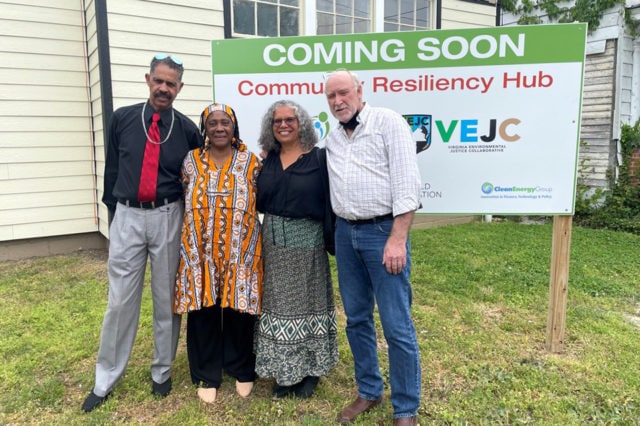Petersburg Resiliency Hub
Resilient power at the Petersburg Resiliency Hub provides safety and self-sufficiency in a disinvested community.

Community Resiliency Hub in Petersburg, VA. Credit: Queen Shabazz, UPAL.
Queen Shabazz became an activist three decades ago, when her young son contracted lead poisoning in their rental home. She soon learned that “lead wasn’t the only problem out there”: her low-income, disinvested community in Petersburg, Virginia, contends with more than its share of environmental hazards — from air pollution to toxic waste. Increasingly, those hazards are compounded by climate change. As the planet warms, Petersburg is experiencing more flash floods, as well as power outages - some that last for days.
“We see so many of these climate events happening,” Shabazz says. “We don’t want to have to wait for someone to come save us.”
So, Shabazz and her colleagues created Virginia’s first solar-powered Resiliency Hub. The Hub serves as a multipurpose community center, as well as the headquarters of two organizations directed by Shabazz: United Parents Against Lead (UPAL) and the Virginia Environmental Justice Collaborative (VEJC). It is housed in an old USO building that served “colored” soldiers in the 1940s — a treasured bit of community history. And, because it is powered with solar panels and energy storage system (solar+storage), the Hub can keep its doors open when the larger grid goes down.
Solar+Storage = Safety
Staying open during a power outage is critical to the mission of the Resiliency Hub — and solar power+storage makes that possible. But the cost of a solar+storage system was prohibitive, until a colleague introduced Shabazz to Clean Energy Group (CEG). In 2020, CEG awarded UPAL a Technical Assistance Fund grant of $10,000. As part of this grant, CEG provided one-on-one support and connected UPAL with an engineer to conduct a solar+storage feasibility study.
With that plan in hand, UPAL secured resources from the Institute for Sustainable Communities and the Honnold Foundation to retrofit the building and install a 33 kW solar+storage system. Grant support enabled UPAL to purchase the system outright, with no financing or debt. In 2022, through the Resilient Power Leadership Initiative, CEG provided UPAL with funding to train community members to install and maintain the solar array.
“The Petersburg Resiliency Hub is proof of concept that resilient power resources can be developed locally and tailored to serve the unique needs of an individual community,” says Marriele Mango, Project Director at CEG.
When fully operational in April 2024, the system will supply 100% of the Hub’s electrical needs. In a crisis, the Resiliency Hub’s battery can power the entire building for several hours, or support critical loads for up to three days. “People will be able to come to the Resiliency Hub and have light, have food, have shelter,” says Shabazz. “They can power up their electronics or their wheelchairs and other medical devices.”
Importantly, Shabazz says, “We are not operating only in times of crisis.” On an ordinary day, the Hub is alive with activity: trainings in lead and mold remediation, classes in safe driving and Basic First Aid, and more. The hub includes a full-service restaurant, cementing its role as a community gathering place. “We are here every day, so people know where to go when something happens,” says Shabazz.
Challenges and Lessons Learned
Not surprisingly, there were challenges along the way. First, Shabazz had to convince the change-resistant historical society to allow solar panels on its building. And the group expected major pushback from the local utility, Dominion Energy, given their longtime adversarial relationship (VEJC fought Dominion on the Atlantic Coast Pipeline, ratepayer overcharges, and other issues). But, with support from community members and local elected officials, those hurdles were overcome.
Shabazz offers succinct advice to other nonprofits considering a solar-powered resiliency hub: “Go for it.” Since each hub will be unique, she recommends they start with community input to identify residents’ needs and wants, then seek grant funding.
“The climate events are getting more intense,” says Shabazz. “We can’t wait for another Katrina, with people left standing on the rooftops. So do what you can to save yourself and those in your community.”
This text was originally written and published by The Kresge Foundation as Petersburg Resiliency Hub solar case study.
Photos
Click on the photos below to view full size with captions.
Installation Details
Year Commissioned
2024
Services Provided
Backup power
Supported Infrastructure
Community center, including an on-site restaurant
Solar
33 kw
Storage
60 kWh of lithium-ion battery
Project Partners
United Parents Against Lead (UPAL), Virginia Environmental Justice Collaborative (VEJC), Institute for Sustainable Communities, the Honnold Foundation, Clean Energy Group, A Mass Construction, Morua Power
Associated Webinar
Implementing Community Programs Alongside Resilience Hub Development (4.25.2023)
Associated Blogs
2022 Year-in-Review: Technical Assistance Fund and Resilient Power Leadership Initiative (12.21.2022)
Solar+Storage for Critical Services Providers: Barriers and Opportunities (4.28.2021)







